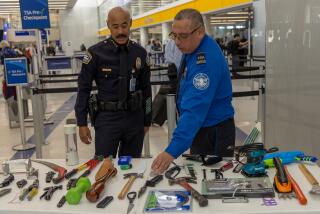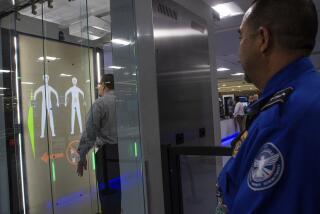Editorial: What a 95% failure rate says about the TSA
Jeh Johnson, head of the Department of Homeland Security, owes an immediate explanation to Americans, many of whom are understandably baffled, worried and shocked by a report that recently leaked out of the Transportation Security Administration. According to the report, undercover federal agents were able to sneak fake bombs past TSA screeners with apparent ease, despite the billions of dollars that the U.S. government spends on airport security and the cumbersome, time-consuming and invasive personal inspections it puts millions of travelers through each year.
In 67 out of 70 tests, secret DHS “Red Team” agents used insider knowledge and disguises to slip past body scanners and pat-downs at airport security checkpoints, carrying weapons, mock bombs or other prohibited items. The TSA’s staggering 95% failure rate was attributed to both human and technological error. The dismal numbers, first reported by ABC News on Monday, were compounded by Johnson’s dismissive response. “The numbers in these reports never look good out of context,” Johnson said in a statement Tuesday. However, he chose not to release the full report or add any context, saying the information was classified.
Maybe there’s some “context” that would make people feel better. Maybe all the tests were conducted at one airport, which travelers could try to avoid. Or maybe the Red Team agents exploited one kind of faulty equipment, which could be replaced. Instead of providing such information, however, Johnson offered this message to travelers: Don’t worry your little heads. We’re taking care of it. Continue to remove your shoes and belts, submit to body scans and keep your complaints to yourselves.
Fourteen years after 9/11, it’s becoming clear this is not an isolated TSA security lapse — just the latest. In May, Homeland Security Inspector General John Roth revealed that his office had conducted a total of eight such covert tests on airport screening operations since 2004 and turned up a number of security failures that persist. Also in recent months, hundreds of TSA employee security badges have gone missing at airports in Atlanta and San Diego. No one knows what has happened to them.
This suggests that the TSA’s 95% failure rate might not be a number taken out of context. Although this country has managed to avoid a major act of aviation terrorism since the TSA was created in 2001, it’s no longer clear if the policies we’ve long accepted as necessary to keep us safe really are.
As President Obama’s nominee for TSA administrator, U.S. Coast Guard Vice Adm. Peter V. Neffenger, continues Senate confirmation hearings, this is an ideal moment for a rethinking of the mission and methods of the agency. The agency is currently leaderless after Johnson reassigned the acting administrator this week after the security test story broke. If Johnson doesn’t come forth to address the Red Team revelations before Neffenger is confirmed, Congress should call him in for a public accounting.
Follow the Opinion section on Twitter @latimesopinion and Facebook
More to Read
A cure for the common opinion
Get thought-provoking perspectives with our weekly newsletter.
You may occasionally receive promotional content from the Los Angeles Times.






